All portable fire extinguishers can stop small fires before they get out of hand, but each extinguisher is specifically suited to only some types of fires
Portable fire extinguishers defend homes, offices, and commercial buildings everywhere against fires. But not all fires and their fuel sources are alike. An extinguisher that doesn’t match the type of fire or doesn’t have enough power may do nothing at all—or make things even worse.
In this article, we take a look at fire classifications and fire extinguisher classes, explaining which extinguishers are best suited to a particular type of fire. Then, we provide an overview of fire extinguisher inspection and help you better understand the basics of purchasing an extinguisher to fit your building’s needs.
Need to shop for an extinguisher now? Feel free to click here to view our selection of fire extinguishers.
How many fire classifications are there and what are they?
Fire classifications simplify the task of matching a fire extinguisher to the expected type of fire. Water, for example, performs well against fires involving wood or plastics—but it would spread fires burning grease or gasoline.
In the United States, fires belong to one of five fire classifications:
- Class A Fire: Ordinary combustibles such as wood, paper, cloth, trash, and plastics.
- Class B Fire: Flammable liquids (excluding grease and cooking oils) like gasoline, petroleum, oil, and paint. Also includes gasses, like propane and butane.
- Class C Fire: Energized electrical equipment like appliances, transformers, and motors. The electricity source must be turned off to aid extinguishing efforts.
- Class D Fire: Combustible metals like titanium, magnesium, aluminum, potassium, sodium, and others.
- Class K Fire: Animal and vegetable fats, cooking oils and greases, and other liquids generally used in food preparation.
In some cases, a fire may belong to two, three, or even more of these classes—in the end, a fire’s class is determined by a mix of the fire’s fuel source and other special hazards that emerge as the material burns.
How does a fire extinguisher work and how should it be used?
Any fire has three essential elements:
- Extreme heat
- Oxygen (or another type of gas)
- Fuel—the burning material
A fire stops burning when any one of these elements is removed. The relationship between these factors is often visualized as a “fire triangle” (pictured below). But while it’s the easiest to visualize, the fire triangle has been largely replaced by the fire tetrahedron. The tetrahedron adds one more element: chain reactions, which create a gaseous fuel that sustains fires.
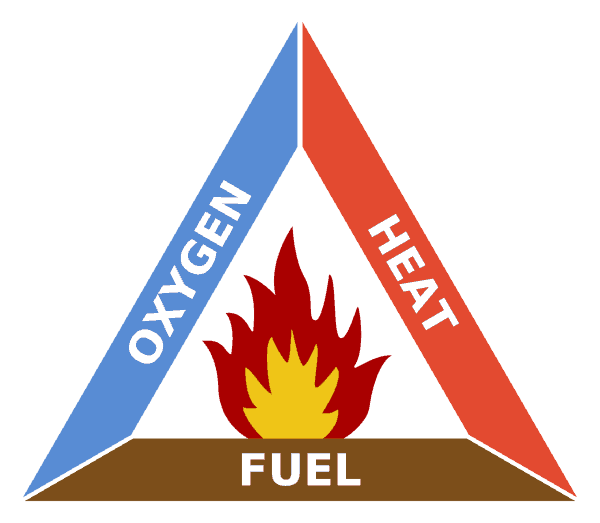
Some extinguishing agents smother the fire, depriving it of oxygen. Others cool the burning material, removing heat. All fire extinguishers are similar in the sense that they deprive the fire of one or more of these elements. But not all extinguishers are effective against the same fires. Some can’t penetrate deeply enough to stop fires in ordinary combustibles, for example, while others can’t stop fires in flammable liquids—and can even spread the fire.
What are the types of fire extinguishers and their uses?
Most fire extinguishers operate in a fashion similar to an aerosol can. The tank contains compressed gas, pressurized liquid, or a combination of the two with an added extinguishing agent. Squeezing the fire extinguisher’s lever creates an opening that allows the compressed material to escape through a nozzle or short hose.
But beyond those mechanical similarities, fire extinguishers vary widely. There are at least eight types of fire extinguishers:
Carbon Dioxide (CO2)
Carbon dioxide extinguishers are Class B and Class C fire extinguishers. They remove the oxygen from the fire triangle and infuse a cold discharge to cool the fire. Unlike water or some other extinguishing agents, CO2 does not conduct electricity, making it especially well-suited for electrical (Class C) fires.
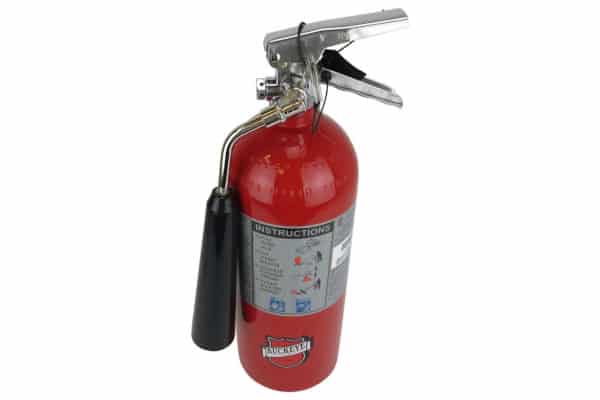
Water and Foam
These extinguishers employ foam agents to remove the heat from the flames. The foam also covers the fuel in a blanket that deprives the fire of oxygen. Water and foam extinguishers are used for Class A fires only. Why? The water in these extinguishers can cause the flammable liquids in Class B fires to spread or increase the shock hazard in a Class C electrical fire.
Dry Chemical
Dry chemical fire extinguishers use multipurpose agents that extinguish Class A, B, and C fires. This suitability for the most common fire types makes these and other “Class ABC” fire extinguishers the go-to choice in homes or offices.
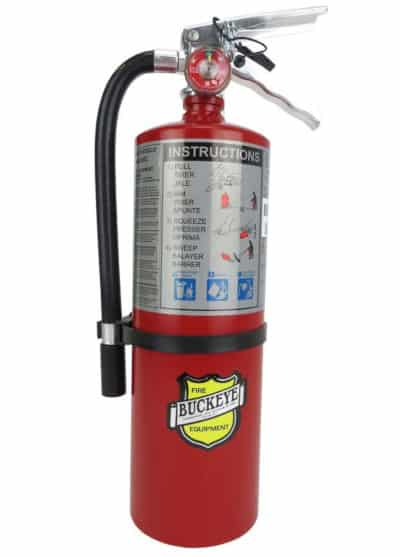
Wet Chemical
Wet chemical extinguishers remove the fire’s heat. The chemical extinguishing agent also creates a barrier between oxygen and fuel. Some wet chemical extinguishers can tame both Class K and Class A fires.
Clean Agent/Halogenated
Clean-agent and halogenated extinguishers deprive fires of heat. They also leave no residue, making them ideal for use in situations where other agents might damage expensive equipment. Most of these extinguishers belong to fire extinguisher Class BC. However, some larger clean agent extinguishers can also fight Class A fires. This equipment provides an environmentally-friendly alternative to Halon extinguishers, which release ozone-damaging chemicals.
Dry Powder
Like dry chemical extinguishers, dry powder extinguishers deprive the fire of oxygen or remove the fire’s heat. These belong to fire extinguisher Class D, making them suitable for use only with combustible metal fires.
Water Mist
Water Mist extinguishers remove the fire’s heat. Some fight only Class A fires while others, surprisingly, can tackle Class C electrical fires. By breaking up water into fine droplets, many of these extinguishers can cleanly put out electrical fires without allowing electricity to travel through the spray. Water mist extinguishers can serve as an alternative to clean agent extinguishers.
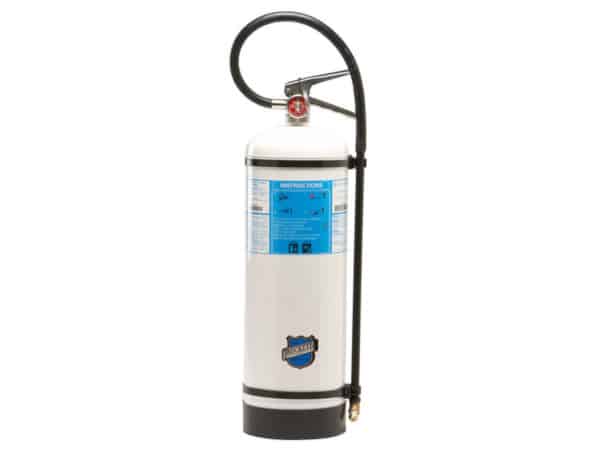
Cartridge Operated Dry Chemical
This multipurpose dry chemical extinguisher works for Class A, B, and C fires. Cartridge-operated dry chemical extinguishers specifically work for Class A fires by creating a barrier between the oxygen and fuel elements.
UL classifications make it easy to choose the right fire extinguisher for a building’s hazards
UL—formerly Underwriter’s Laboratories—establishes widely-used performance standards for fire extinguisher manufacturers. As part of these standards, extinguishers are labeled with UL classification ratings used to determine which kinds of fires they can effectively fight.
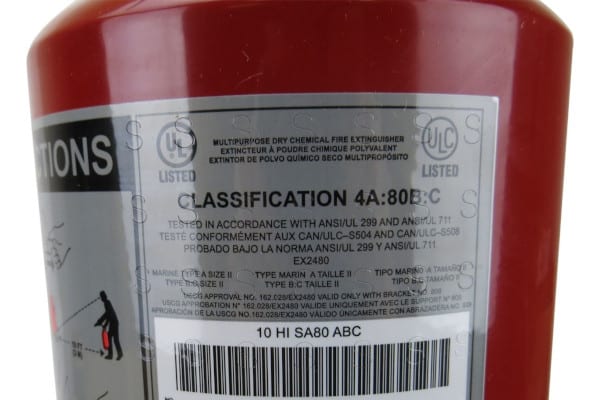
The letters in these ratings indicate the fire extinguisher’s class. A 2A:10B:C fire extinguisher, for example, can be used on Class A, B, and C fires. The numbers preceding the letters “A” or “B” indicate how effective the fire extinguisher is at extinguishing that particular type of fire.
For each number before the A, the extinguisher’s agent delivers the extinguishing equivalent of 1.25 gallons of water. 8A extinguishers, then, are as powerful against ordinary combustibles as 10 gallons of water (8 x 1.25 = 10). The number before the B rating represents square footage—a well-handled 10B extinguisher can stop 10 square feet of Class B fires. The “C” is omitted for extinguishers not suitable for use on energized electrical equipment. When this letter is included, the extinguisher can stop other fires in accordance with its rating (usually, Class A, Class B, or Class A and B) even if there’s electrical equipment involved. It doesn’t have a number; a “C” simply indicates that the extinguishing agent doesn’t conduct electricity.
Some extinguishers also include a “K” rating, indicating suitability for use against hot cooking oils and greases. However, “K” extinguishers also do not include a water equivalent or square footage rating. Also—and this can be confusing—it’s crucial to distinguish extinguishers rated for Class K fires from “Purple K” extinguishers. The latter uses a different, potassium-bicarbonate-based dry chemical agent specially designed for Class B and Class C fires.
Notably, UL does not provide a numerical or letter rating for Class D fires. Instead, the manufacturer indicates the extinguisher’s suitability against specific metal fires elsewhere on the label.
Regular fire extinguisher inspection and servicing is required
According to the Occupational Safety and Health Administration (OSHA), fire extinguishers used in the workplace must be visually inspected on a monthly basis. This mandate parallels standards from the National Fire Protection Association (NFPA) that require building owners to verify, at intervals not exceeding 31 days, that fire extinguishers are properly pressurized, easily accessed, and in good condition.
During a monthly inspection, all extinguishers must be in their designated place and visibly marked. Inspectors should weigh or lift each extinguisher to ensure that it has plenty of extinguishing agent available. Finally, the person inspecting the equipment should document, sign, and date the results. All fire extinguishers should list the year and month of the last inspection and the extinguisher’s expiration date on a tag.
All fire extinguishers should have more thorough inspection and maintenance on an annual basis. They should undergo a complete visual examination, checking for damage, corrosion, dents, and wear. Hoses must also be checked for blockage and use and replaced if the inspection turns up evidence that the fire extinguisher has been used.
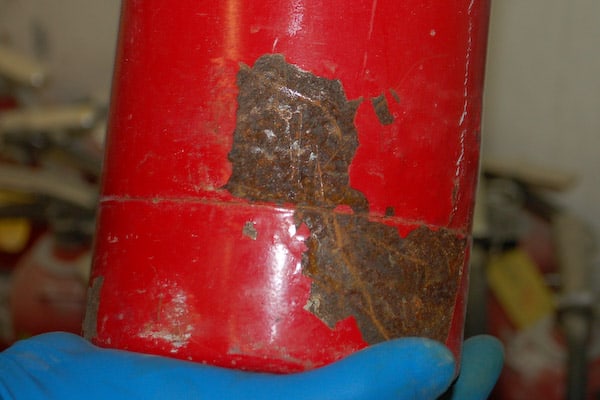
These inspections should also determine if a fire extinguisher requires a hydrostatic test. Hydrostatic tests pressurize an extinguisher to determine if the tank has weakened. Because a weakened fire extinguisher poses the threat of failure or explosion upon use, extinguishers that fail hydrostatic tests may not return to service. The frequency of required hydrostatic tests varies with the extinguisher’s type, but dry chemical ABC extinguishers—the most common type—must undergo testing at least every 12 years.
What to look for when buying a fire extinguisher online
Here are a few tips that can make it easier to put all this information together and buy a fire extinguisher online:
- Check to make sure the extinguisher meets your building’s requirements. If you are unsure, check with the authority having jurisdiction (AHJ)—typically, your local fire marshall.
- Select the extinguisher type and size to suit the needs and hazards of the room or building. Remember, class ABC fire extinguishers can combat a broad range of fires in combustibles, flammable liquids, and electrical fires. For a closer look at the standards governing extinguisher placement, see our guide to when and where fire extinguishers should be installed.
- Ensure that every extinguisher you purchase is fully charged.
- Because fire extinguishers are considered hazardous materials by the Department of Transportation (DOT), they must be labeled or marked appropriately to ensure their safe transportation from one location to another.
Purchase or replace your fire extinguisher with QRFS!
If you need a new fire extinguisher, take a look at our selection of CO2 and dry chemical ABC extinguishers. We ship from several locations in the United States, which means we can get your new extinguisher to you fast!
All extinguishers come fully charged and operable. To get started, click on one of the ABC or CO2 extinguishers pictured in the table below or explore our full selection of fire extinguishers. Also, be sure to check out our selection of fire extinguisher covers, fire extinguisher cabinets, fire extinguisher vehicle brackets, extinguisher mounting and storage options and fire extinguisher decals.
Beyond our online inventory, QRFS has access to almost any fire extinguisher you could need, including wheeled on/offshore models, dry chemical, halotron, mist and foam systems, nitrogen-operated and dry-powder models, and more. If you’re looking for an extinguisher that isn’t listed on this page, call us at +1 (888) 361-6662 or email support@qrfs.com.
ABC Dry Chemical Fire Extinguishers
With a spray distance ranging from 9-21 feet (varies by size), and models from 2.5 to 20 lbs, these completely rechargeable, these corrosion-resistant dry chemical extinguishers will exceed your expectations year over year. You can view our entire selection of dry chemical ABC fire extinguishers by clicking here.
| Type | Description |
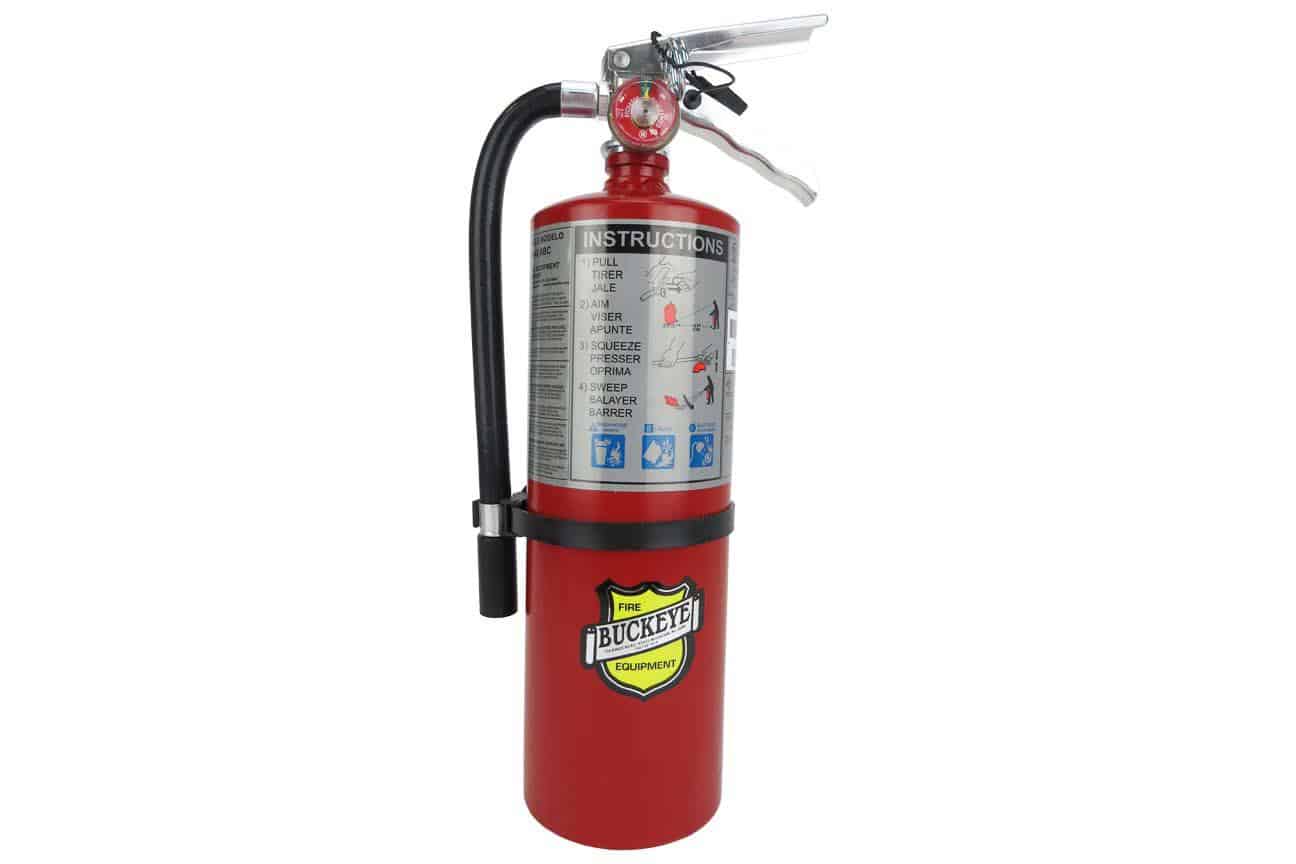 2.5 lb ABC Dry Chemical Extinguisher 1A:10B:C – ANSI/UL |
|
 5 lb ABC Dry Chemical Extinguisher 3A:40B:C – ANSI/UL |
|
 10 lb ABC Dry Chemical Extinguisher 4A:80B:C – ANSI/UL |
|
 20 lb ABC Dry Chemical Extinguisher 10A:120B:C – ANSI/UL |
|
CO2 Fire Extinguishers
With a range of 4-8 feet and high-performing discharge valves, the CO2 extinguishers from QRFS will meet your specific requirements every time. View our selection of CO2 extinguishers here.
| Type | Description |
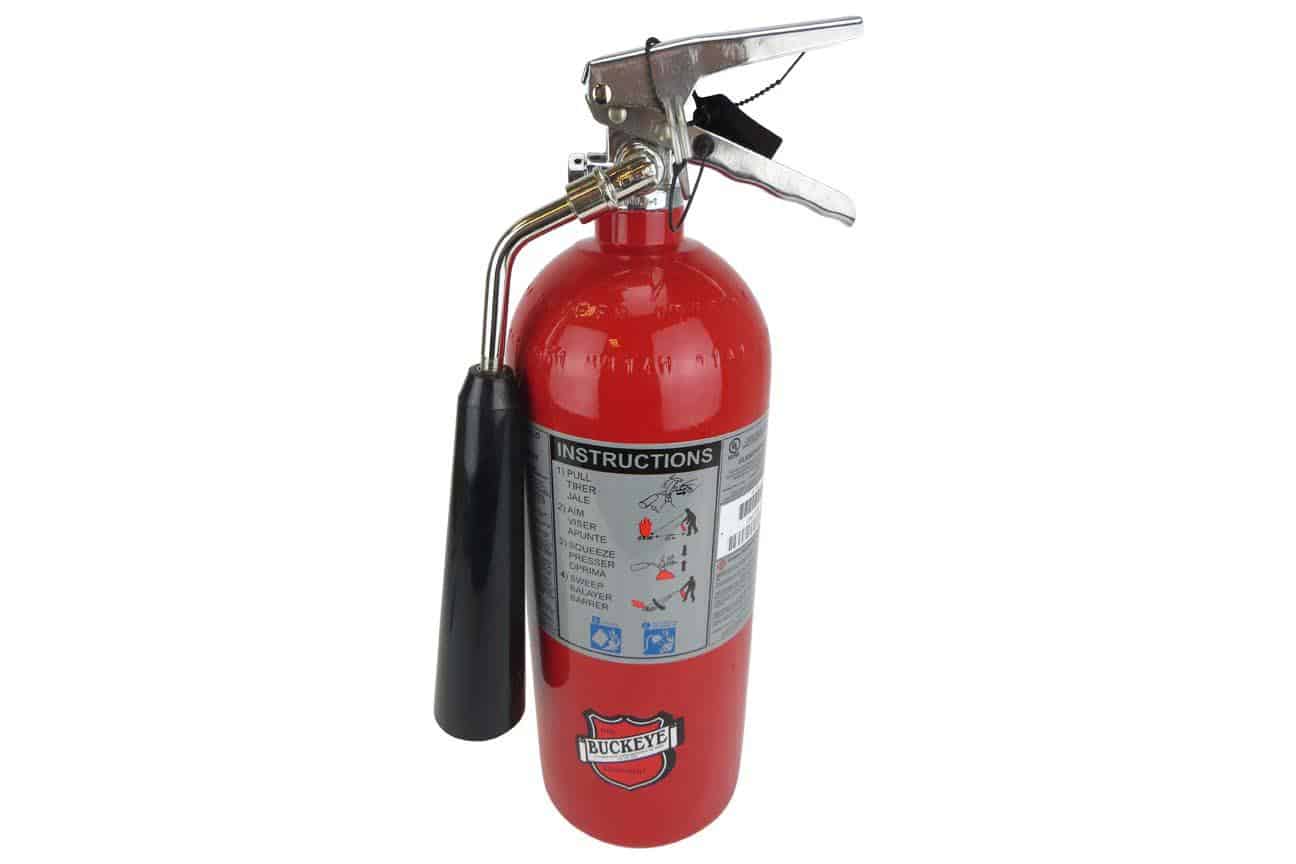 5 lb CO2 Extinguisher 5B:C – ANSI/UL |
|
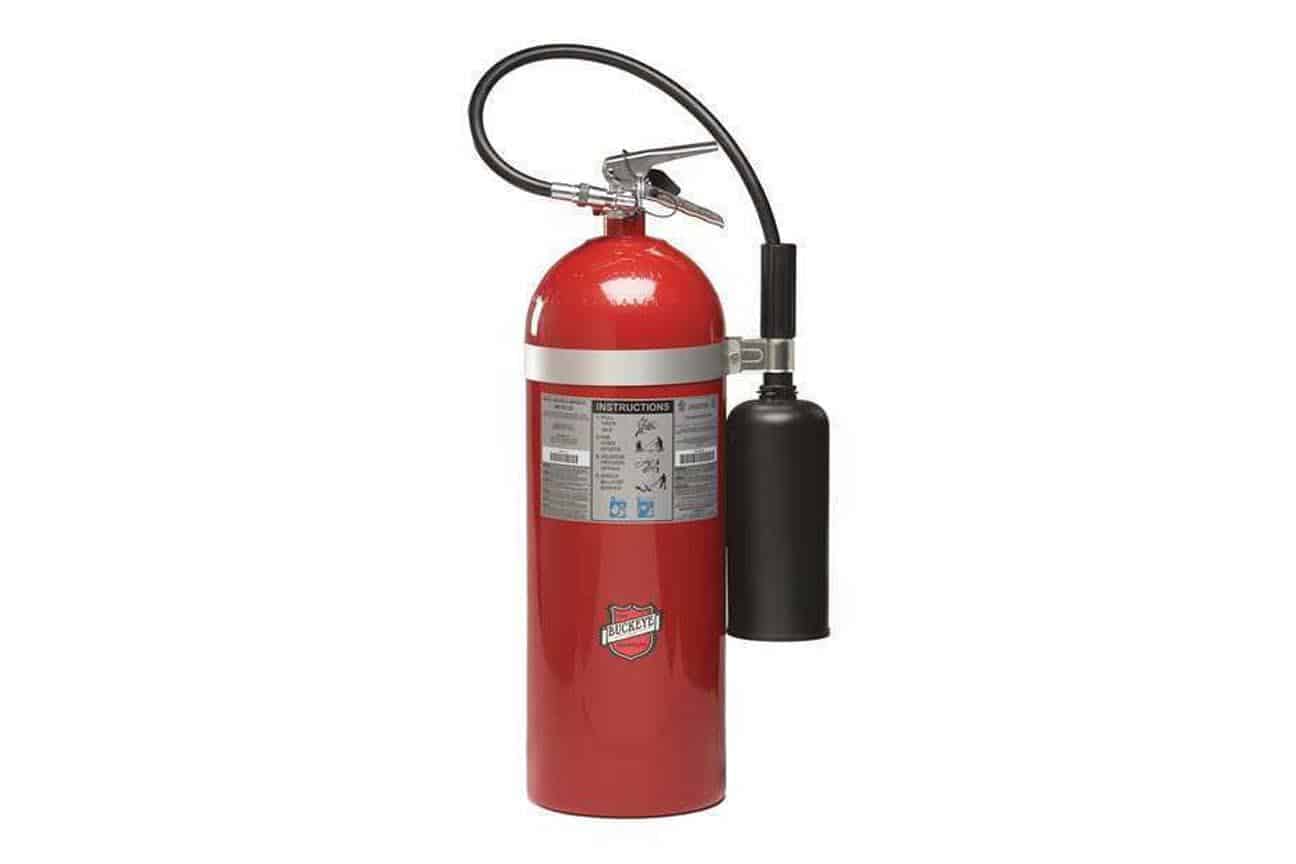 10 lb CO2 Extinguisher 10B:C – ANSI/UL |
|
 15 lb CO2 Extinguisher 10B:C – ANSI/UL |
|
 20 lb CO2 Extinguisher 10B:C – ANSI/UL |
|
Purple K Fire Extinguishers
Our Purple K extinguishers tackle Class B and C fires with a spray distance ranging from 15-21 feet and a discharge time of 27 seconds.
| Type | Description |
20 lb Purple K Dry Chemical Extinguisher – ANSI/UL |
|
This blog was originally posted by Jason Hugo and Anna Hartenbach at blog.qrfs.com on June 8, 2017, and updated on February 24, 2022. If this article helped you learn a thing or two about fire extinguishers, check us out at Facebook.com/QuickResponseFireSupply or on Twitter @QuickResponseFS.


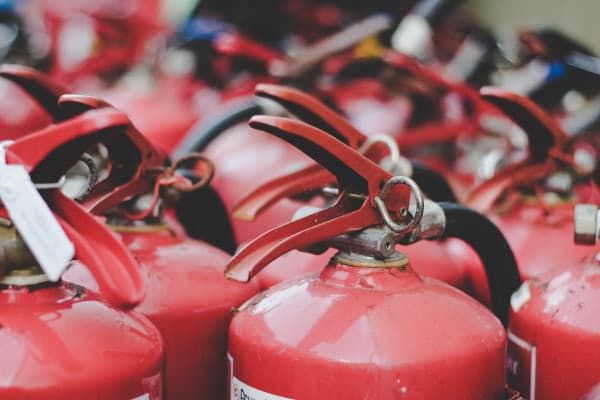
Would you use type K FE for a residential kitchen? I didn’t see selections for that.
Dean — You could use a Class K extinguisher in a home kitchen, but they are typically found in commercial kitchens, where the risk of a large grease fire is much more significant. Grease fires in home kitchens typically start small, and they can be put out by placing the lid over a pot or pan or with a fire blanket (though this is also uncommon in home kitchens but maybe shouldn’t be). That said, there is no harm in having a Class K on hand, and it will certainly do the job!
Hi I have about 80 fire extinguishers that I need to go on transportation, do they need to have ADR and what’s the best to pack them in please
Lisa — ADR falls under European regulations governing shipping, which is outside of our expertise. Best of luck!
Hello, I would like to place orders for some of your products, I would like to know if I can place orders with my credit card and if I can arrange to pick them up from your store/warehouse by a private freight company. I will be looking forward to your quick response soon. Thanks
Thank you for reaching out. We will have someone from our QRFS Customer Support Team contact you, and you can also email any requests there to get faster service!
Can you use a type b c extinguisher for a type fires
Kevin — the appropriate fires will be marked by the letters. So, ABC extinguisher, yes, BC should not be used.